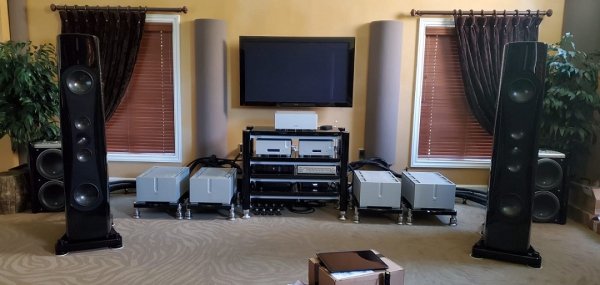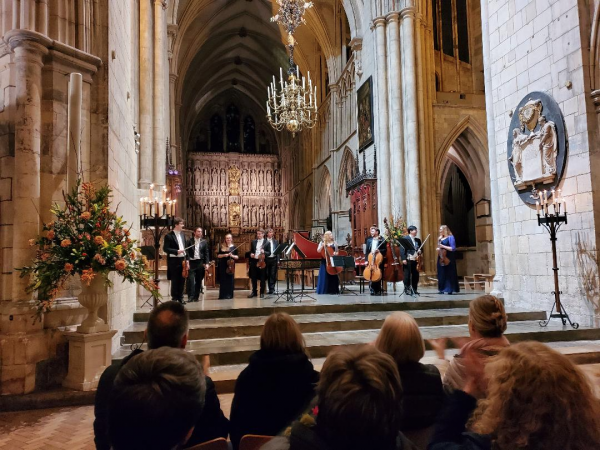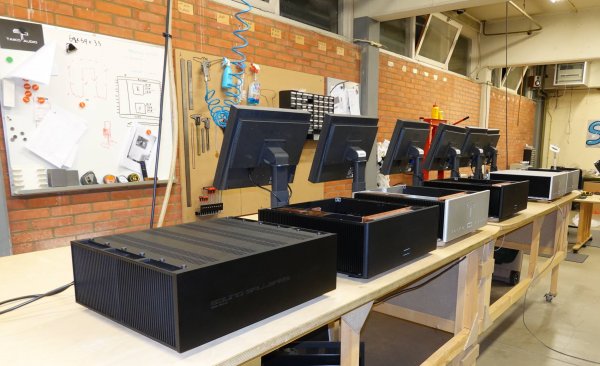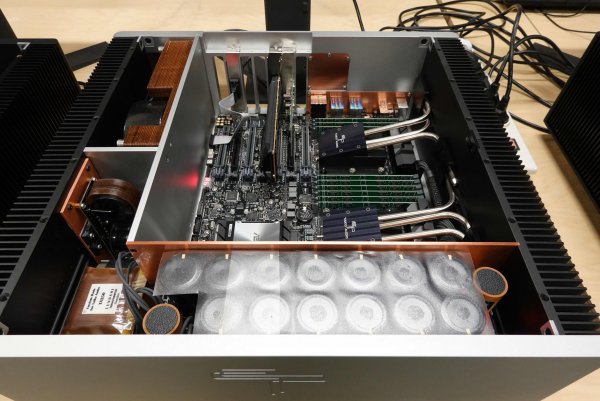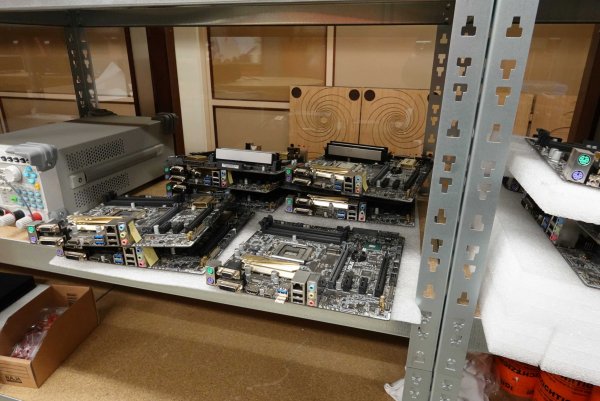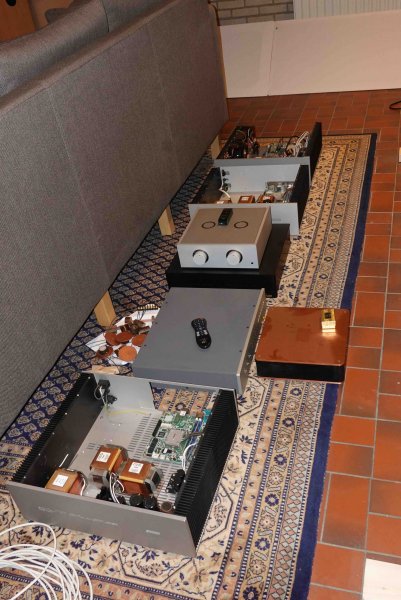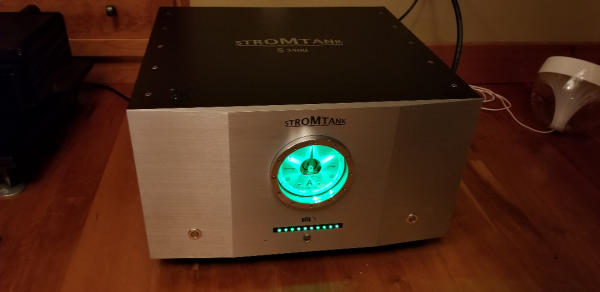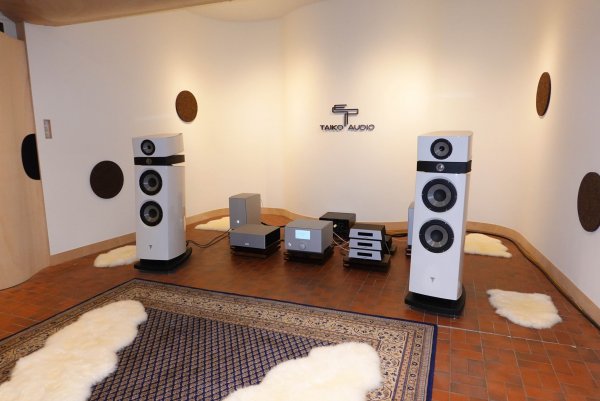A few weeks back, I paid a visit to Emile at his workshop in Hengelo. This would be my first opportunity to hear the Extreme and what better way to experience it than in a room that was specifically designed by its creator to showcase its capabilities? Prior to arriving to Emile's, my wife and I calibrated our ears by taking in a Baroque concert at the Southwark Cathedral in London. I have no vinyl or tape to use as a reference but I suspect a live unamplified acoustical performance will do.
View attachment 59672
Hengelo was a short flight from London and a 2 hour train ride from Amsterdam and while it was raining and dreary outside, I enjoyed some of the beautiful countryside that The Netherlands had to offer. Emile was kind enough to pick me up from the train station and despite the long journey that began in California days before, the journey was worthwhile as my day spent with Emile was both educational and inspiring.
Here is a row of SGM servers currently in various stages of burn-in. Emile suggests that during the first 5 days, the Extreme can sound quite dreadful and so before he ships one out, each Extreme goes through a mandatory 5 day burn in. Sometimes, customers request a longer burn in and Emile indicated he is happy to oblige.
View attachment 59674
Surprisingly, he suggested it is the 48GB of RAM that results in such horrible SQ during the burn in process. Regardless, it was immediately evident that the quality of workmanship and attention to detail is impeccable. There are apparently many chassis that are discarded because they fail to meet Emile's perfectionist standards and so it is the chassis anodization process that is often the reason for production delays.
What was most impressive to me is that these machines that you see here are being burned in 24/7 via a process that stress the CPUs and so these machines should run quite hot but because of the effectiveness of his passive cooling design including the utilization of expensive copper heat sinks (painted black) in critical areas, this machine barely ran warm to the touch. This is not something you will find with some of the Extreme's competition.
It's also easy to notice the extensive use of copper in other areas not just for copper's superior heat dissipating qualities but also because of its much more musical resonant qualities. You'll also note the German Panzerholz wood his transformers are mounted on to minimize vibrations. When I asked Emile why he chose a combination of Mundorf and Dueland capacitors for the Extreme's power supply, he said it was because it sounded better that way. Emile showed me a bin that contained various types of capacitors he had tried and didn't like and so nothing in the Extreme is there unless it has been carefully vetted. It is obvious that this machine is more than the sum of its parts. It is a carefully tuned machine through proprietary hardware and software optimizations that would be near impossible for anyone to reverse engineer. I suspect there may be some in Emile's camp that wonder why he shares the technology in the Extreme so freely but like any good chef knows, just knowing the ingredients doesn't guarantee a good cake, let alone a cake of worldwide acclaim.
View attachment 59675
As for the stock server-grade ASUS motherboard used in the Extreme, I have often wondered why Emile didn't design his own motherboard like Antipodes and Innuos have and it turns out Emile has. As I have a background heavily entrenched in DIY, I have explored motherboard design myself and if one has the capital, any of these motherboard manufacturers will gladly build you one. What Emile found, however, was the motherboard he designed didn't sound better. In fact, he tested dozens of boards and I was able to witness for myself some of these boards that failed to make the cut including several that were in active prototype form.
View attachment 59676
View attachment 59677
In the end, what one needs to know is that the Extreme is not just a music server, it is an embodiment of Emile himself. While Emile is not a one man show, this machine has his fingerprints all over it. This includes years of university level IT experience consisting of both computer and networking development and deployment with an emphasis on maximizing process efficiency, a quality that is quite evident in the Extreme's design. It also includes countless hours of noise spectra measurements at a cost of more than a hundred Euros per hour and ultimately, careful listening tests because good measurements don't always guarantee natural sound.
So what did I think of the Extreme's sound qualities? At this point, I can't really say. I can only tell you how Emile's listening room sounds as a whole. Emile was up front and told me there are times when his mains quality is horrendous because of the industrial machinery used by neighboring tenants. I asked him why he didn't invest in a Stromtank battery supply similar to the one I had in my home recently for evaluation as this would disconnect his system from the mains?
View attachment 59678
He told me it was important that he designed the Extreme to excel under real world conditions. It's the same reason he doesn't use exotic fuses or cables. Unlike his customers who build their systems for musical enjoyment, this listening room is more of a test lab designed to be transparent and revealing of flaws.
View attachment 59679
It's the reason he chose the Focal Maestro Utopia Evo speakers. At their best, Focals are among the finest speakers I have heard but with the wrong front end, their beryllium tweeters, while extremely resolving can also sound fatiguingly bright. As for the Audionet Stern and Heisenberg monoblocks, having tried the Audionets in my home briefly, they drove my Wilson Alexia 2s with ease and while very fast and resolving, you would never mistake them for tubes. Relative to my D'Agostino Momentum amplification, I thought the CH Precision sounded dry but the Audionets sounded even drier. And so I prepared myself for a sound presentation that would be accurate, resolving, and transparent but perhaps bordering on the clinical.
I was wrong. As Emile queued up various tracks including complex orchestral soundtracks, accuracy, resolution, and transparency were there in spades but not at the expense of musicality. In fact, for large orchestral music, this presentation was very much my preference! I was expecting a thinner signature because having recently tried his Startech SFP PCIe card in a recent DIY build, this is what I heard but somehow, the presentation was full bodied with just enough harmonic richness. Just as importantly, the presentation was neither too bright nor too dark but rather neutral and nicely balanced. Even though his revised TotalDac d1-drivers had not yet arrived, I felt there was excellent dynamics with plenty of "you are there" vibrancy and immediacy. Some people tune their rooms to sound intimate as if the artists are performing in the room. I prefer systems that make you feel you have been transported to Carnegie Hall if that is where the performance actually took place. It's a much more difficult trick and the presentation at Emile's was quite believable.
Emile and I did some A/B testing of optical network cabling vs a long run of cheap copper Ethernet cabling and while to my ears, there was a very obvious difference in favor of optical, the cheap Ethernet cabling sounded very good, good enough to live with if I had to and not complain and so I can understand why some people who own the Extreme would feel no need to tinker further.
Having been to Munich this past May and to RMAF, Axpona, THE Show in Newport, the LA Audio Show, the California Audio Show in San Francisco, and CES over the past 2 years, I have had a chance to listen to a number of excellent systems but for my tastes, probably none that were better than what I heard in Emile's listening room. It is a testament to his ability to properly configure an audio setup and impressive enough for me to proceed with an order for my own Extreme.
I first met Emile in Munich at the SGM booth in 2017 and while speaking with Emile, I was impressed with his ability to make me feel like I was the only person in the room despite the fact that the room was packed with people. Those who have had the opportunity to personally interact with Emile know what I am talking about. He is generous with his time and sharing of knowledge and I couldn't have dreamt up a more enjoyable visit. Emile, thank you.












